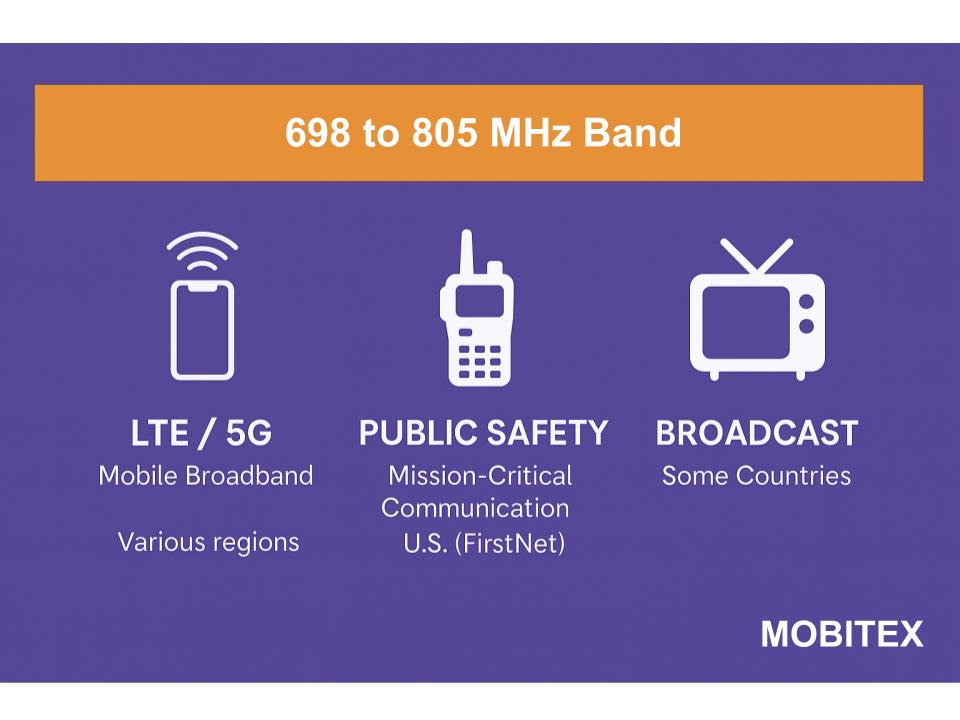📶 The 698–805 MHz band sits at the upper end of the UHF (Ultra High Frequency) spectrum and plays a pivotal role in modern mobile broadband, public safety, and broadcast services. Originally used for analog and digital TV broadcasting, this band has undergone major transformation as regulators worldwide repurpose it to meet growing demand for 4G LTE, 5G, and mission-critical communications.
🌍 Frequency Overview
- Frequency range: 698 MHz – 805 MHz
- Wavelength: ~43 cm – 37 cm
- ITU classification: UHF Band (Part of ITU Region-dependent allocations)
- Propagation characteristics: Excellent coverage and penetration — ideal for both urban and rural connectivity
This band’s ability to provide long-range communication and strong indoor penetration makes it one of the most valuable frequency ranges below 1 GHz.
📺 Historical Use – TV Broadcasting
Before the digital transition, 698–805 MHz was primarily allocated for UHF television channels 52–69. These channels delivered broadcast TV across large geographic areas with minimal transmission power compared to higher-frequency bands.
After the digital switchover, most broadcasters were repacked into lower UHF frequencies (below 614 MHz), freeing this portion of the spectrum for new, high-demand services.
📡 Current Uses and Allocations
📱 Mobile Broadband (LTE / 5G)
Today, the 698–805 MHz band is among the most valuable for mobile operators.
- In North America, the 700 MHz band (698–806 MHz) underpins LTE Bands 12, 13, 14, 17, and 29 — critical for rural and suburban coverage.
- In Asia, Africa, and Latin America, this spectrum supports LTE Band 28 (703–748 / 758–803 MHz), a harmonized allocation endorsed by the 3GPP for global LTE and 5G networks.
- The low frequency ensures wide coverage per cell site, reducing infrastructure costs in rural deployments.
These low-band frequencies also serve as coverage layers for 5G, complementing higher-capacity mmWave and mid-band deployments.
🚨 Public Safety and Mission-Critical Communication
A portion of this band (especially around 758–768 MHz and 788–798 MHz in the U.S.) is allocated for public safety broadband.
- The FirstNet network in the U.S. operates here, providing a dedicated LTE-based system for first responders.
- Similar networks exist or are being planned globally to support police, fire, and emergency medical services, often leveraging LTE or 5G NR for interoperability and reliability.
🎤 Broadcast Auxiliary Services (Legacy)
Before the mobile reallocation, parts of this band supported wireless microphones, intercoms, and ENG (electronic news gathering) equipment.
These uses have largely moved to other frequency ranges (e.g., 941–960 MHz or 1.9 GHz bands) due to stricter interference protections for mobile and safety networks.
🌐 Rural Connectivity & Fixed Wireless Access (FWA)
In many developing regions, portions of the 700–800 MHz band are being used for fixed wireless access, helping to close the digital divide.
Because signals in this band travel far and penetrate obstacles effectively, it’s ideal for delivering last-mile broadband where fiber or cable are impractical.
⚙️ Regional Allocation Summary
| Region | Primary Uses | Notes |
|---|---|---|
| North America | LTE/5G mobile broadband, public safety (FirstNet) | Former TV channels 52–69 repurposed post-digital transition |
| Europe | Mobile broadband (700 MHz plan), digital broadcasting (DVB-T2) | Harmonized 703–733 / 758–788 MHz allocation |
| Asia-Pacific | LTE Band 28 / 5G NR n28 | Key frequency for rural coverage expansion |
| Latin America | Mobile broadband, limited broadcasting | Major focus on 700 MHz LTE deployment |
| Africa | Mixed: digital TV, broadband rollout | Gradual transition to mobile networks via digital switchover |
🧭 Technical Parameters
| Property | Description |
|---|---|
| Frequency range | 698–805 MHz |
| Common 3GPP bands | LTE Bands 12, 13, 14, 17, 28; 5G n12, n28 |
| Propagation | Long range, strong building penetration |
| Channel bandwidths | Typically 5–20 MHz |
| Applications | LTE, 5G NR, public safety broadband, fixed wireless |
💡 Advantages of the 700–800 MHz Range
✅ Excellent coverage — ideal for rural and suburban regions
✅ Fewer base stations needed, lowering deployment costs
✅ Strong indoor performance
✅ Global harmonization supports international roaming and device interoperability
⚠️ Challenges and Considerations
⚡ Interference management with remaining broadcast services near 600 MHz or 800 MHz edges
⚡ Cross-border coordination needed due to overlapping allocations in some regions
⚡ Limited bandwidth availability – typically less than 100 MHz total
⚡ Need for careful coexistence with public safety and broadcasting services
🛰️ The Future of the 698–805 MHz Band
This band remains one of the most strategically valuable parts of the spectrum for both developing and developed markets. As more countries finalize digital TV transitions, the 700–800 MHz range will continue to:
- Expand 5G rural coverage
- Enable public safety broadband networks
- Support IoT and connected infrastructure for smart cities and agriculture
Its balance of range, performance, and reliability ensures it will remain a foundation for national wireless ecosystems for decades.

